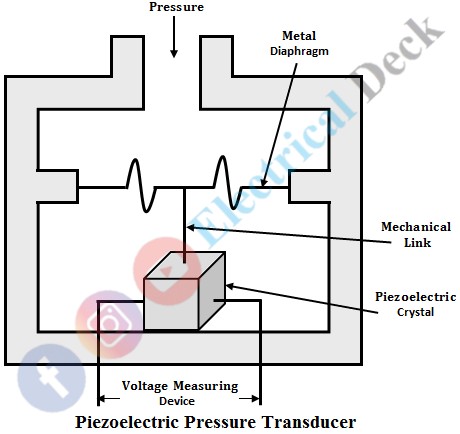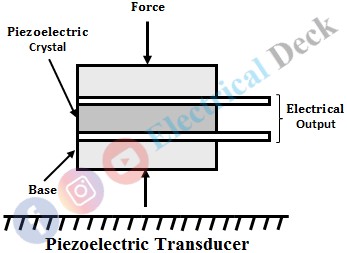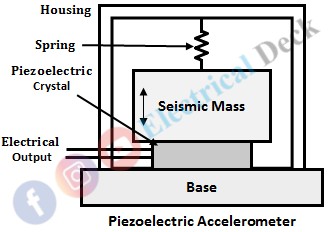The phenomenon of the piezoelectric effect in piezoelectric transducers can be used for the measurement of various physical quantities like force, pressure, acceleration, etc.
It is an active transducer (doesn't need any external power supply for its excitation) that converts physical quantity to be measured into an electrical signal (voltage). The converted electrical signal is proportional to the physical quantity and by measuring the electrical signal, the physical quantity applied is determined.
Measurement of Pressure Using Piezoelectric Transducer :
A piezoelectric transducer can be used for the measurement of pressure. A piezoelectric transducer consists of a piezoelectric crystal that develops an electric charge or potential when subjected to stress. The material used for the construction of piezoelectric crystals are lithium sulfate, quartz, Rochelle salt, etc, and are called piezoelectric materials.
A piezoelectric transducer used in the measurement of pressure uses a flat or corrugated diaphragm connected to the piezoelectric crystal as shown below. Unlike resistive, inductive, and capacitive pressure transducers, piezoelectric pressure transducers take advantage of them due to their self-generating electrical property, which eliminates the use of an external source of power.
When the corrugated metal diaphragm is subjected to pressure. The applied pressure is converted into proportional displacement, and this displacement signal is transmitted to the piezoelectric crystal through a mechanical link. By transferring pressure to the crystal through the diaphragm and link, the crystal is subjected to mechanical stress and develops a charge. or potential.
The potential developed is proportional to the applied pressure. Therefore, the measure of voltage gives the applied pressure once the voltage measuring instrument is calibrated in terms of applied pressure.
Advantages of Piezoelectric Pressure Transducer :
- The construction is rugged and small in size.
- Since it is an active transducer, there is no need for an external electrical source.
- Can be used for measuring dynamic pressure.
Disadvantages of Piezoelectric Pressure Transducer :
- It is an expensive pressure measuring transducer.
- It cannot be used for static pressure measurements.
- It requires signal conditioning circuitry which increases cost and the circuit becomes complex.
- The temperature variations can introduce errors in the measurement.
Measurement of Force Using Piezoelectric Transducer :
The below shows the arrangement of the piezoelectric transducer in force measurement. The functioning of the transducer is as follows. When the force is applied to the transducer, an electrical charge appears on the faces of the piezoelectrical crystal. The charge that appeared is directly proportional to the applied force. The charge is also a function of force direction. Here the measurement of charge is a direct measure of applied force.
The piezoelectric transducer differs from the conventional transducer in two ways. First, it is an active transducer, secondly, the distortion after application of force is not more than a few thousandths of a millimeter whereas the deflection in any convention transducer may be about several tenths of a millimeter.
The piezoelectric transducer has a small size, rugged construction, high stiffness due to which it has a very high resonant frequency and it is sensitive to temperature variations. It is capable of measuring compressive forces from a few kN to about 1 MN with accuracy from 0.5 - 1.5%.
Piezoelectric Accelerometer (Measurement of Acceleration) :
The piezoelectric effect can be also used for the measurement of acceleration and it is called as piezoelectric accelerometer. When the acceleration to be measured is applied to the piezoelectric crystal causes mechanical stress on the crystal and results in the generation of electrical voltage. The measure of voltage generated gives the acceleration applied.
A piezoelectric accelerometer employs a piezoelectric crystal, mass, crystal electrodes, spring. A seismic mass is placed on the surface of the piezoelectric crystal that is between two crystal electrodes. Then this piezoelectric crystal is loaded by means of a spring. This total assembly is placed in a housing and referred to as the piezoelectric accelerometer.
This accelerometer is attached to a system or object whose acceleration is to be known. In the presence of acceleration, the spring presses the seismic mass due to which force is applied to the crystal. The equation for force is,
Where,- F = Applied force
- m = mass
- a = acceleration.
The force exerted on the crystal is proportional to the acceleration since the mass is fixed or constant. Application of this force to the crystal a voltage to develop across the crystal. This output voltage gives the measure of the force and hence acceleration.



